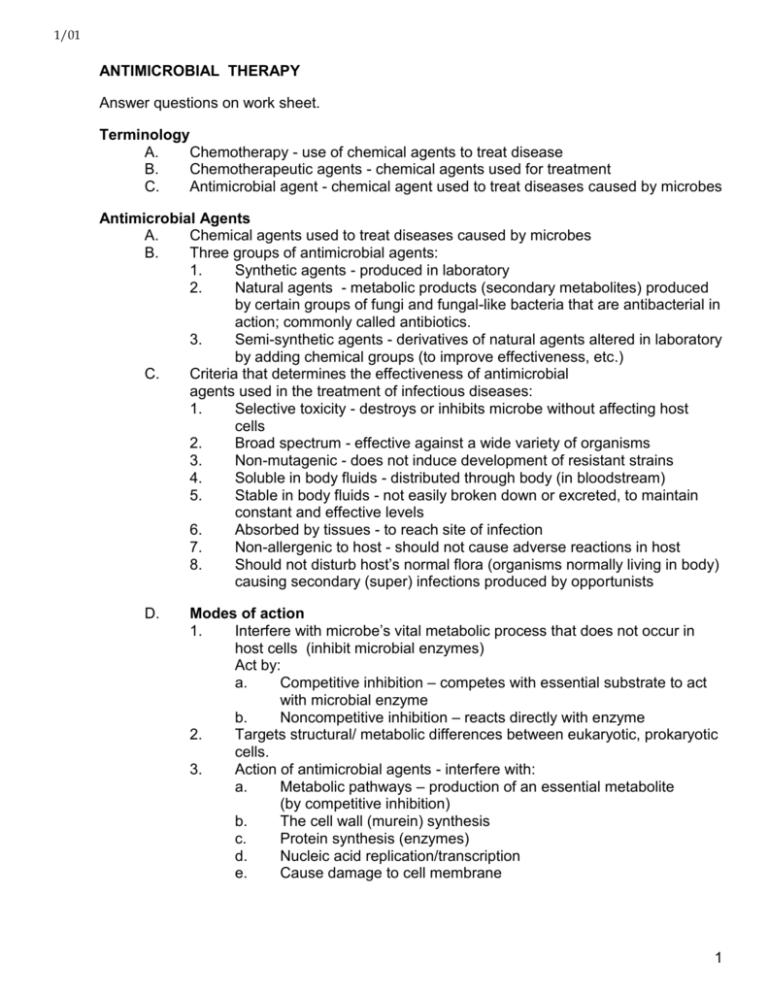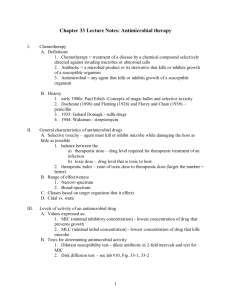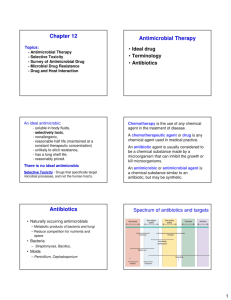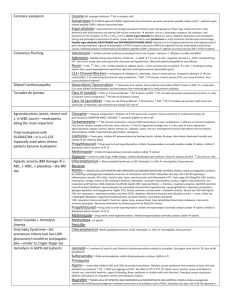Antimicrobial Agents
advertisement

1/01 ANTIMICROBIAL THERAPY Answer questions on work sheet. Terminology A. Chemotherapy - use of chemical agents to treat disease B. Chemotherapeutic agents - chemical agents used for treatment C. Antimicrobial agent - chemical agent used to treat diseases caused by microbes Antimicrobial Agents A. Chemical agents used to treat diseases caused by microbes B. Three groups of antimicrobial agents: 1. Synthetic agents - produced in laboratory 2. Natural agents - metabolic products (secondary metabolites) produced by certain groups of fungi and fungal-like bacteria that are antibacterial in action; commonly called antibiotics. 3. Semi-synthetic agents - derivatives of natural agents altered in laboratory by adding chemical groups (to improve effectiveness, etc.) C. Criteria that determines the effectiveness of antimicrobial agents used in the treatment of infectious diseases: 1. Selective toxicity - destroys or inhibits microbe without affecting host cells 2. Broad spectrum - effective against a wide variety of organisms 3. Non-mutagenic - does not induce development of resistant strains 4. Soluble in body fluids - distributed through body (in bloodstream) 5. Stable in body fluids - not easily broken down or excreted, to maintain constant and effective levels 6. Absorbed by tissues - to reach site of infection 7. Non-allergenic to host - should not cause adverse reactions in host 8. Should not disturb host’s normal flora (organisms normally living in body) causing secondary (super) infections produced by opportunists D. Modes of action 1. Interfere with microbe’s vital metabolic process that does not occur in host cells (inhibit microbial enzymes) Act by: a. Competitive inhibition – competes with essential substrate to act with microbial enzyme b. Noncompetitive inhibition – reacts directly with enzyme 2. Targets structural/ metabolic differences between eukaryotic, prokaryotic cells. 3. Action of antimicrobial agents - interfere with: a. Metabolic pathways – production of an essential metabolite (by competitive inhibition) b. The cell wall (murein) synthesis c. Protein synthesis (enzymes) d. Nucleic acid replication/transcription e. Cause damage to cell membrane 1 1/01 4. Examples of agents and their actions (see handout) a. Sulfonamides - Metabolic Pathway 1). Inhibits synthesis folic acid by competitive inhibition 2). Similar in structure to PABA – substrate for folic synthesis 3). Sulfa drugs compete with PABA for active site on enzyme 4) Sulfa drugs react with active site on enzyme 5). Inhibits enzyme and folic acid synthesis 6). Bacteriostatic b. Penicillin - Cell Wall Synthesis 1). Binds to & inhibits enzyme – penicillin-binding proteins 2). Inhibits formation peptide (amino acid) cross bridges 3). Inhibits formation bond between amino acid & muramic acid 4). Weakens cell wall lysis bacterial cell 5). Bactericidal c. Erythromycin – Protein Synthesis 1). Binds to bacterial ribosome (protein) 2). Inhibits translocase – catalyzes movement codons (mRNA) on active site ribosome 3). “Freezes” mRNA on ribosome 4). Stops synthesis of protein (enzymes) 5). Bacteriostatic d. Tetracyclines - Protein Synthesis 1). Binds to bacterial ribosome 2). Blocks attachment tRNA-amino acid to ribosome-mRNA 3). Amino acid not added to a.a. chain(protein) 4). Stops protein synthesis 5). Bacteriostatic e. Chloramphenicol - Protein Synthesis 1). Binds to bacterial ribosome – transferase 2). Prevents transfer of a.a on tRNA to a.a. chain 3). Stops protein synthesis 4). Bacteriostatic f. Streptomycin - Protein synthesis 1). Binds to active site on ribosome 2). Distorts active site on ribosome misreading 3). Wrong a.a. bonded together 4). Nonsense protein (nonfunctional) protein produced 5). Bactericidal g. Quinolones - DNA Synthesis 1). Inhibits DNA gyrase (produced by prokaryotic cells) 2). Prevents replication bacterial DNA h. Rifampin - RNA Synthesis 1). Inhibits RNA polymerase (produced by prokaryotic cells) 2) Prevents transcription (synthesis mRNA) Ii AZT - DNA Synthesis 1). Inhibits reverse transcriptase 2) Prevents viral RNA viral DNA 2 1/01 j. k. l. Acyclovir, Ribavirin - DNA, RNA Synthesis 1). Act as guanine analogues 2). Similar in structure to viral guanine 3). Replace guanine in nucleotides 4). Cannot be incorporated into viral DNA 5). Inhibit synthesis viral DNA 5). Prevents viral replication Griseofulvin - RNA Synthesis 1). Binds to keratin 2). Inhibits RNA polymerases 3). Prevents mitosis fungi (dermatophytes) Polymixins - Damage Cytoplasmic Membrane 1). Structure – two solubilities a). One end – water soluble (hydrophilic) b). One end – lipid soluble 2). As absorbed across cell membrane: a). Water soluble end – affinity for water soluble proteins, water in cytoplasm b.) Lipid soluble end – affinity to phospholipid layers 3). Causes cleavages (openings) in cell membrane 4). Loss of cell contents 5). Bacteriocidal E. Disadvantages of Antimicrobial Therapy: 1. Allergic reactions 2. Toxic effects on normal tissues 3. Disturbs host normal flora secondary infections 4. Development of resistant strains – spontaneous mutations, DNA transfer a. Ability to destroy AMA by producing enzymes (Staph –penicillinase or -lactamase) b. Mutations causing structural changes in cell so bypass metabolic step inhibited by AMA (L-forms - no cell wall) c. Over produce target molecules increase in quantity overcomes action of AMA d. R-factors (resistant genes) in plasmids transferred to bacterial cells by conjugation, transformation, transduction F. Avoid disadvantages by: 1. Avoiding indiscriminate use of AMA 2. Maintain proper levels 3. For sufficient (prescribed) length of time 4. Use a combination of 2 or more AMA when resistance develops synergistic effect 5. Do antibiotic sensitivity test to determine the most effective AMA 3 1/01 G. Antibiotic Sensitivity Test -- Disk-plate (diffusion) method 1. Procedure a. Isolate and identify causative pathogen b. Grow pathogen in pure culture c. “Seed” surface agar plate - inoculate entire surface with pure culture d. Place paper antibiotic disks on surface of agar e. Incubate 24 hours, observe growth around disks 2. Principle: during incubation antibiotic diffuses into agar, if effective, inhibits growth 3. Observations: a. Zone of inhibition (no growth) - effective (positive) b. No zone of inhibition (growth) - not effective (negative) c. Resistant strains - isolated colonies in zone of inhibition 4








